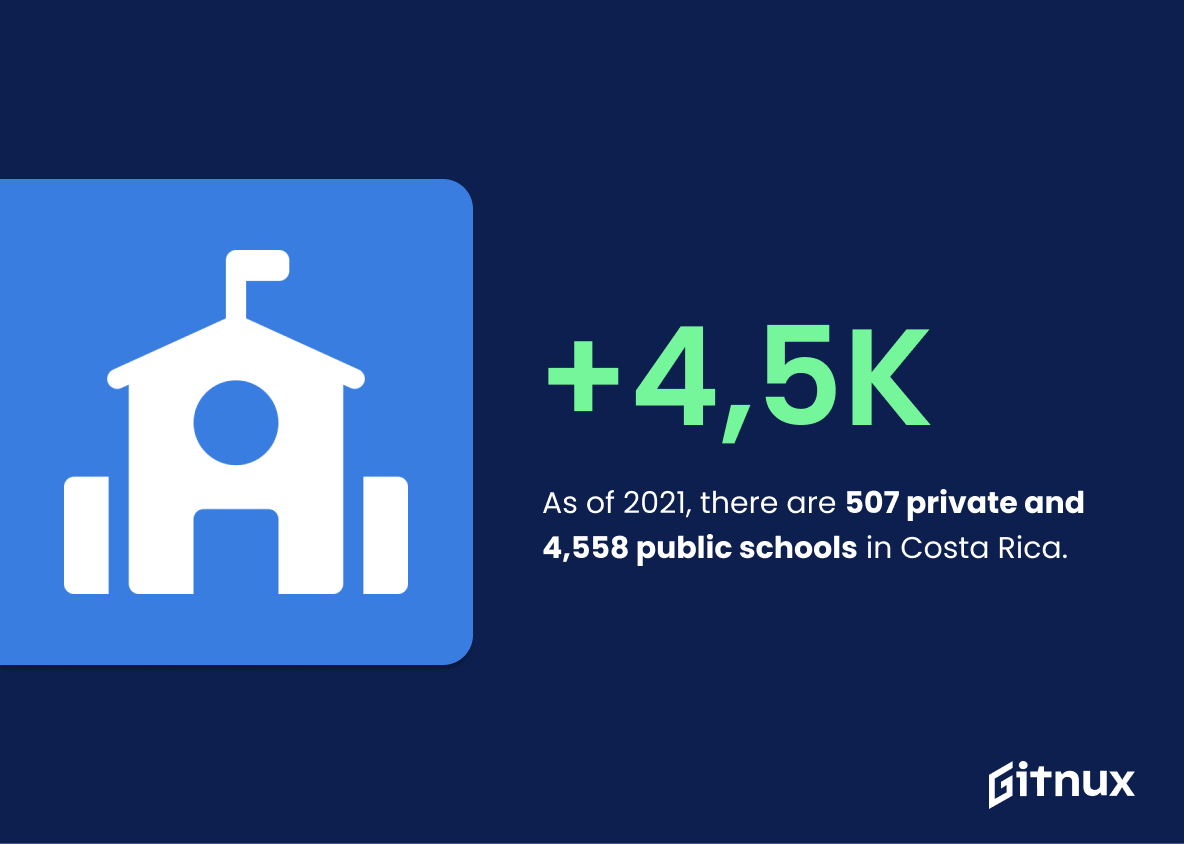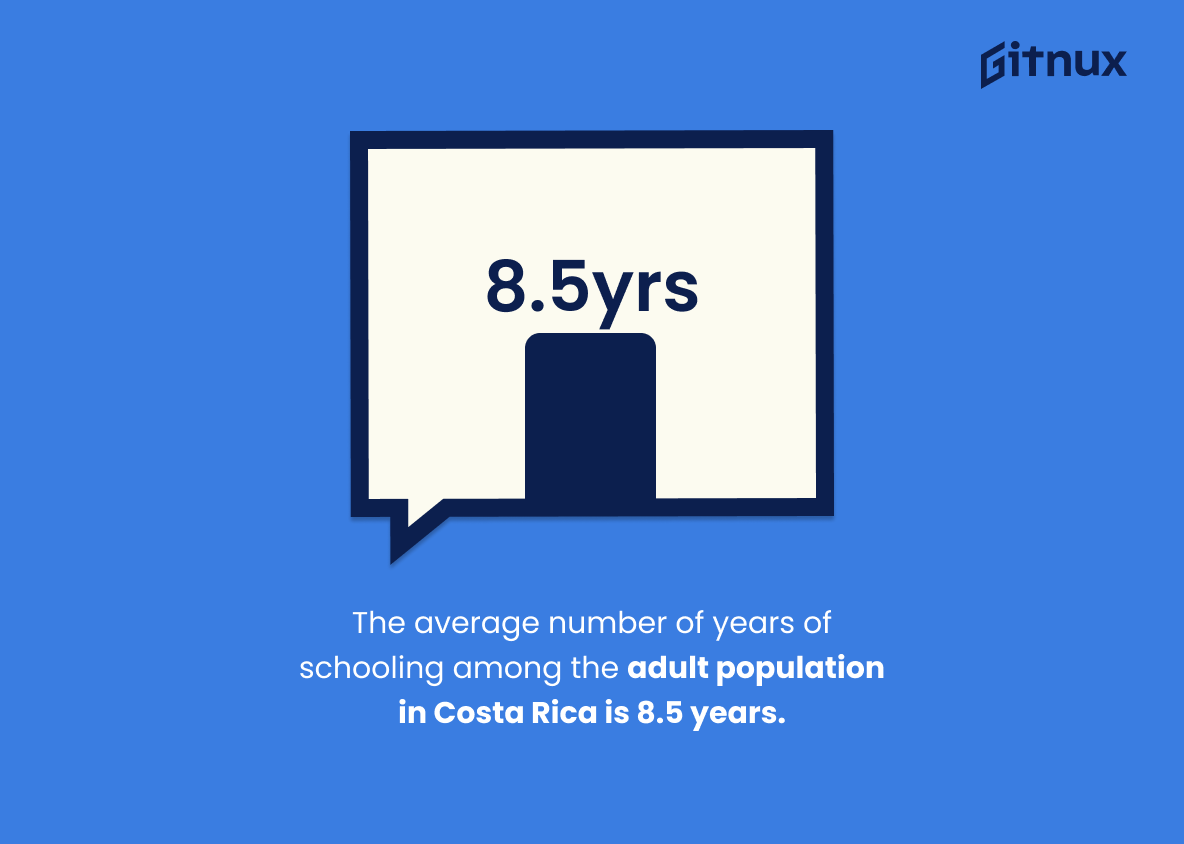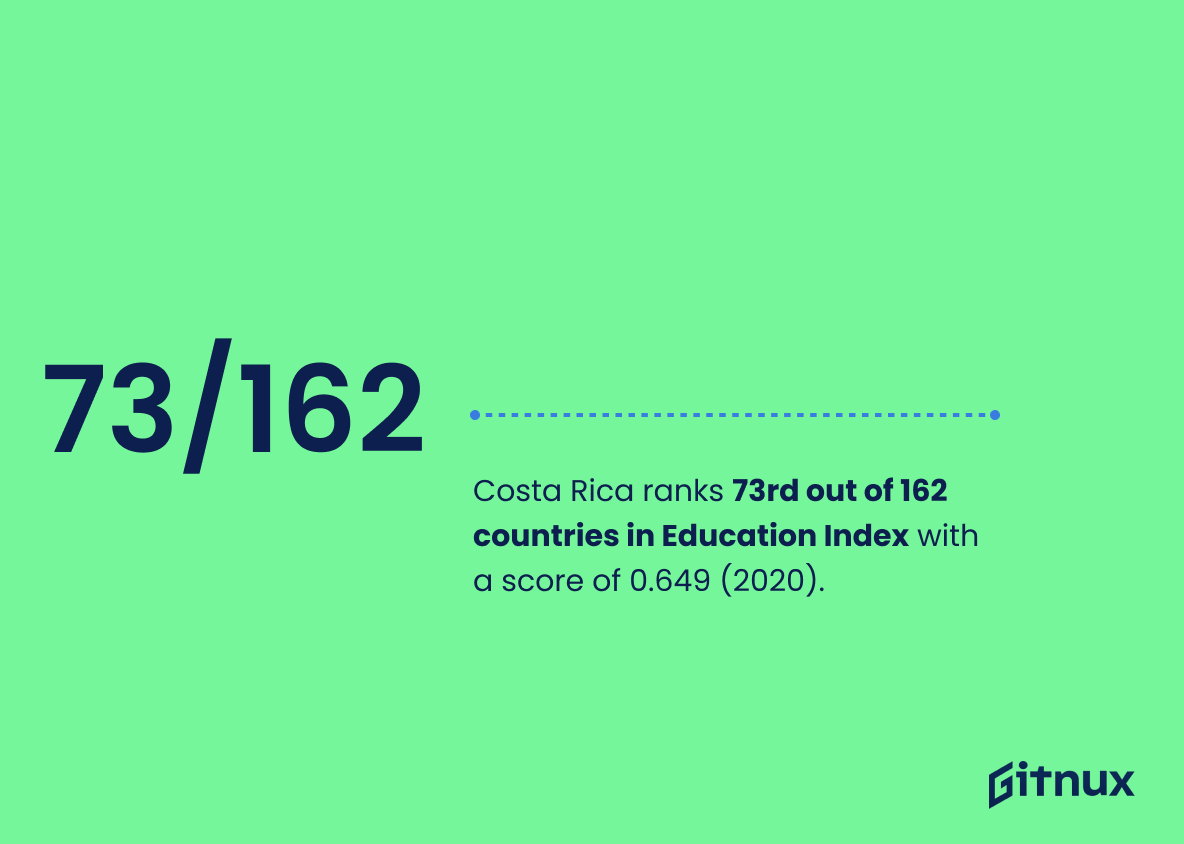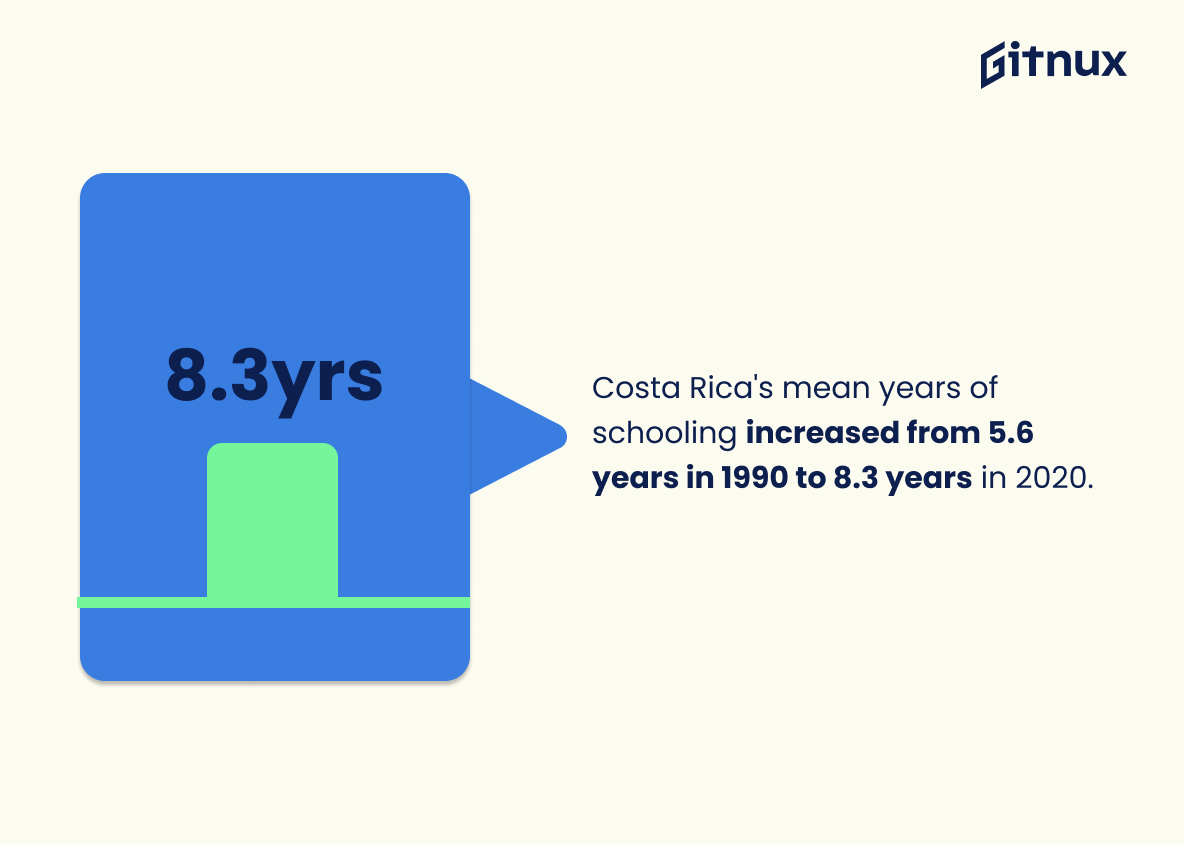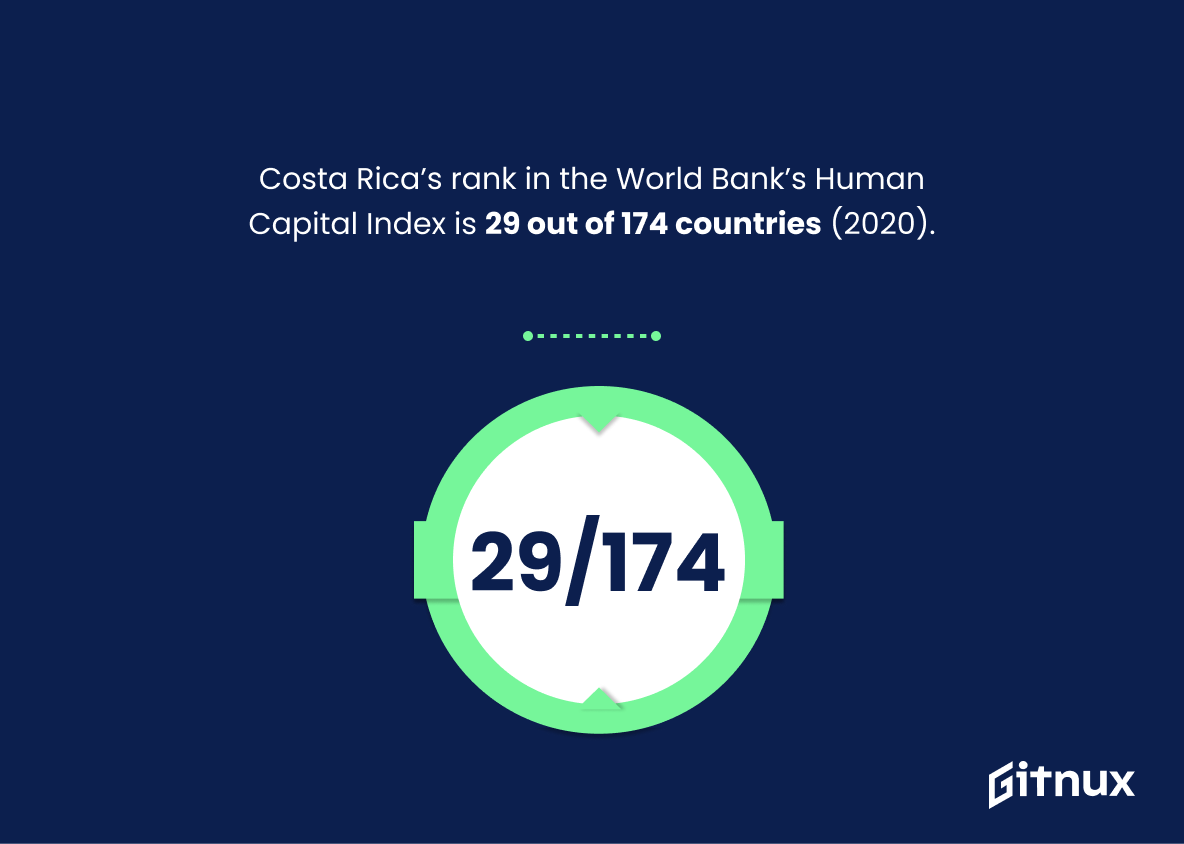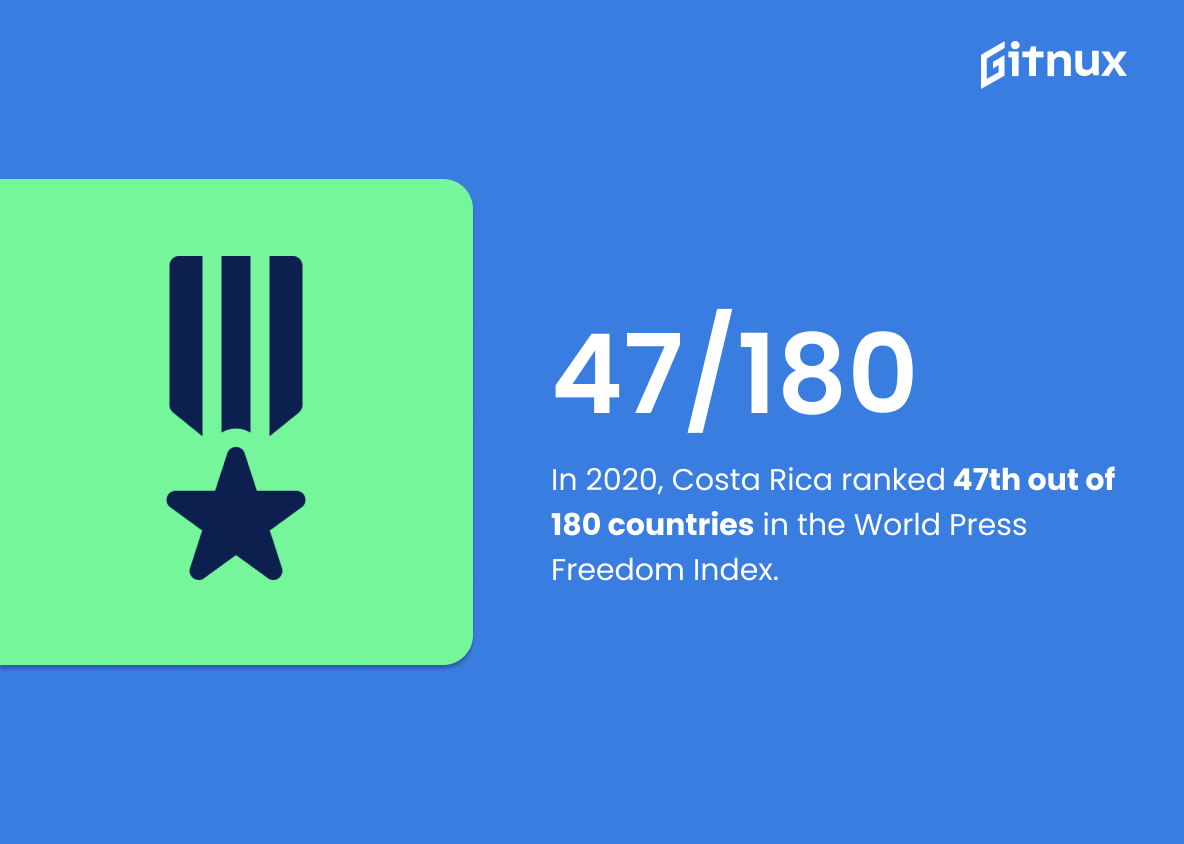Costa Rica is a country with an impressive education system. With a literacy rate of 97.98%, Costa Rica has one of the highest rates in Latin America and the Caribbean region, according to Macrotrends (2019). In 2019, 7.22% of its GDP was invested in education (Redatam, 2020), while 72% of pre-primary and primary graduates were enrolled in private schools as per UNESCO data from 2016 (UIS, 2021).
The number of public and private schools stands at 4558 and 507 respectively as per World Bank Data for 2021(World Bank Data Portal, 2021). The average years spent on schooling among adults aged 15+ is 8.5 years according to UNDP Human Development Report 2020 (UNDP HDR2020) . Additionally , Costa Rica ranks 73rd out of 162 countries when it comes to Education Index with 0.649 score for 2020(World Population Review ,2020 ). Gross enrollment ratio for Pre-Primary , Primary Secondary & Tertiary Education are 76.11 % 9941 % 89 61 % & 52 00 % respectively based on 2017 UIS figures.(UIS 2017 ) Female – Male Enrollment Ratio across all levels stand at 1:1 :1 04 : 1 58 respectively also based on UIS Figures from 2017 .
Teacher Student Ratios across Primary & Secondary Levels stand at 14:1 12:1 Respectively again based off UIs Figures from 2017 . According To World Banks Human Capital Index report For Year 2020 Costa Ricas Rank Is 29 Out Of 174 Countries Worldwide.(WB HCI Report 202O ) There Are 5 Public Universities And Around 50 Private Ones As Per Nacion Educacions Reports From 2019.(Nacion Educaciones 2019) Lastly Press Freedom index by Reporters Without Borders ranked costa rica 47th out Of 180 Countries In Their Latest Ranking From year 20201((RSF WPI2021)) Finally PISA 2018 Results Showed That Numeracy Proficiency Rate Among 15 Year Old Students Was At 503 Percent ((Pisa2018)).
The impressive literacy rate of 97.98% in Costa Rica is a testament to the country’s commitment to education. It is a clear indication that Costa Rica is dedicated to providing its citizens with the knowledge and skills necessary to succeed in life. This statistic is a powerful reminder of the importance of investing in education and the positive impact it can have on a nation’s development.
In 2019, Costa Rica invested 7.22% of its GDP in education.
The fact that Costa Rica invested 7.22% of its GDP in education in 2019 is a testament to the country’s commitment to providing quality education to its citizens. This investment is a reflection of the nation’s dedication to the development of its people and its future. It is a sign that Costa Rica is taking the necessary steps to ensure that its citizens have access to the resources and opportunities they need to succeed.
Costa Rica Education Statistics Overview
As of 2021, there are 507 private and 4,558 public schools in Costa Rica.
This statistic is a telling indication of the educational landscape in Costa Rica. It reveals that the majority of schools in the country are public, which speaks to the commitment of the government to providing quality education to its citizens. Furthermore, it also highlights the importance of private schools in the country, which provide an alternative option for those who are looking for a different educational experience.
The average number of years of schooling among the adult population in Costa Rica is 8.5 years.
This statistic is a telling indication of the educational attainment of the adult population in Costa Rica. It provides insight into the educational opportunities available to the people of Costa Rica, and how well they are taking advantage of them. It also serves as a benchmark for comparison with other countries, and can be used to measure the progress of Costa Rica’s educational system over time. In short, this statistic is an invaluable tool for understanding the state of education in Costa Rica.
Costa Rica ranks 73rd out of 162 countries in Education Index with a score of 0.649 (2020).
This statistic is a testament to the educational progress Costa Rica has made in recent years, as it ranks 73rd out of 162 countries in Education Index with a score of 0.649 (2020). This impressive ranking is indicative of the country’s commitment to providing quality education to its citizens, and serves as a reminder of the importance of investing in education.
Costa Rica’s mean years of schooling for the population aged 15 years and older increased from 5.6 years in 1990 to 8.3 years in 2020.
This statistic is a testament to the progress Costa Rica has made in the realm of education. It shows that the country has made significant strides in providing its citizens with the opportunity to gain knowledge and skills, which can be used to improve their lives and the lives of their families. This statistic is a powerful indicator of the success of Costa Rica’s educational system and its commitment to providing quality education to its citizens.
Costa Rica’s rank in the World Bank’s Human Capital Index is 29 out of 174 countries (2020).
This statistic is a testament to the progress Costa Rica has made in the realm of human capital development. It highlights the country’s commitment to providing quality education and healthcare services to its citizens, which has enabled them to reach a high ranking in the World Bank’s Human Capital Index. This is an important indicator of the country’s overall economic and social development, and is a key factor in understanding the success of Costa Rica’s education system.
In 2020, Costa Rica ranked 47th out of 180 countries in the World Press Freedom Index.
The World Press Freedom Index is an important indicator of the level of freedom of expression in a country. By ranking 47th out of 180 countries, Costa Rica’s press freedom is relatively high, suggesting that citizens have access to a wide range of information and can freely express their opinions. This is important for education, as it allows for a more open dialogue between students, teachers, and administrators, and encourages the free exchange of ideas and knowledge. Furthermore, a free press can help to ensure that educational institutions are held accountable for their actions and that any issues or concerns are addressed in a timely manner.
The numeracy proficiency rate among 15-year-old students in Costa Rica was 50.3% in 2018.
The numeracy proficiency rate among 15-year-old students in Costa Rica is a telling statistic when it comes to the state of education in the country. It serves as a barometer of the educational system’s success in preparing students for the future, as numeracy skills are essential for success in the modern world. This statistic is a crucial indicator of the quality of education in Costa Rica and should be taken into account when discussing the country’s educational system.
Conclusion
Costa Rica has made significant strides in improving its education system over the past few decades. The country boasts a literacy rate of 97.98%, and invests 7.22% of its GDP into education, which is higher than many other countries around the world. Additionally, 72% of Costa Rican graduates are enrolled in private schools, with 507 private and 4558 public schools across the nation as of 2021.
The average number of years spent on schooling among adults is 8.5 years while gross enrollment ratios for pre-primary to tertiary levels stand at 76%, 99%, 90% and 52%. Furthermore, female students have equal access to primary and secondary level educations with 1:1 ratio respectively; however they outnumber males when it comes to tertiary level enrollments (1:58).
Teacher-student ratios also remain favorable at 14:1 for primary schoolers and 12:1 for secondary schoolers respectively indicating that there are enough teachers available per student in both cases allowing them more individual attention from their instructors if needed or desired by either party involved.. Finally, Costa Rica ranks 73rd out of 162 countries according to Education Index score 0f 0649 (2020)and 47th out 180 nations based on World Press Freedom Index 2020 making it one amongst top performing nations globally when it comes educational standards & freedom related matters . Numeracy proficiency rate among 15 year old students stands at 50 %(2018).
Overall these statistics demonstrate that Costa Rica’s commitment towards providing quality education opportunities has been successful thus far – though there may be room for improvement going forward – ensuring future generations will benefit from an even better learning environment than what exists today.
References
0. – https://www.hdr.undp.org
1. – https://www.rsf.org
2. – https://www.worldpopulationreview.com
3. – https://www.datos.bancomundial.org
4. – https://www.macrotrends.net
5. – https://www.openknowledge.worldbank.org
6. – https://www.oecd.org
7. – https://www.redatam.org
